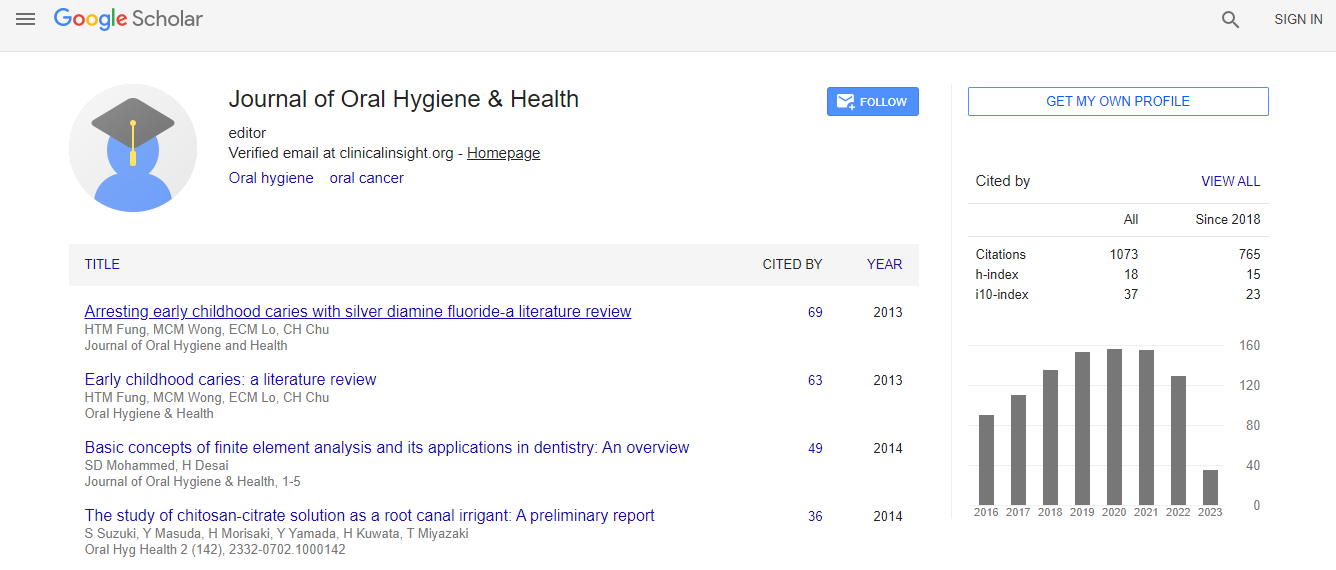Our Group organises 3000+ Global Conferenceseries Events every year across USA, Europe & Asia with support from 1000 more scientific Societies and Publishes 700+ Open Access Journals which contains over 50000 eminent personalities, reputed scientists as editorial board members.
Open Access Journals gaining more Readers and Citations
700 Journals and 15,000,000 Readers Each Journal is getting 25,000+ Readers
Google Scholar citation report
Citations : 1073
Journal of Oral Hygiene & Health received 1073 citations as per Google Scholar report
Journal of Oral Hygiene & Health peer review process verified at publons
Indexed In
- Index Copernicus
- Google Scholar
- Open J Gate
- JournalTOCs
- RefSeek
- Hamdard University
- EBSCO A-Z
- OCLC- WorldCat
- Publons
- Geneva Foundation for Medical Education and Research
- Euro Pub
- ICMJE
Useful Links
Recommended Journals
Related Subjects
Share This Page
The effect of metal surface treatment before reporcelainization for ceramic repair after adhesive fracture of ceramo-metallic restoration
13th International Conference and Exhibition on Dental Medicine
Suhayla Reda Hassan Al Banai
Hamad Medical Corporation, Qatar
Posters & Accepted Abstracts: J Oral Hyg Health
Abstract
Introduction: Ceramic fracture over non-precious crown coping is a clinical disaster causes a problem for the clinician. The problem is of great importance since till now there is lack of literature/researches that investigate this point. The high cost of the precious metals has simulated interest in less expensive alloys for the casting of Crown & Bridge. We intended to share in solving the problem in regard to the best treatment of bare metal for the best bond strength. Aim: To investigate the effect of metal surface treatment (sandblasting, grinding and grinding) followed by sand blasting before repocelainization of the bare metal on the bond strength and to shed some light on the mechanism of metal ceramic bonding. Material & Methods: Two non-precious dental casting alloys, a nickel-chromium and a cobalt-chromium alloys and one type of dental ceramic were used. A total of 80 rod shaped metallic samples, 40 samples for each alloy were used for bond strength measurements and for metallographic study. Results: Bond strength evaluation test: Co-Cr alloy exhibited the highest mean bonding value followed by Ni-Cr. For Ni-Cr alloy the highest mean bond strength was obtained when the bare metal was treated with sandblasting. For Co-Cr alloy, the highest mean bond strength was obtained when the bare metal was treated with sandblasting and when it was treated with grinding with P120D silicon carbide emery paper. Conclusions: It is possible to repair the metal/porcelain restoration interface after adhesive fracture. Direct reporcelainization (without metal surface treatment) on the bare metal also gives adequate bond strength. Sandblasting increases the bond strength of metal/porcelain interface for both the investigated alloys, namely Ni-Cr and Co-Cr. The cobalt-chromium alloy shows better bond strength with sandblasting than the nickel-chromium alloy. Grinding procedure should not be used as a metal surface treatment before reporcelainization because it lowers the bond strength in case of base metal alloys.Biography
Email: salbanai@hamad.qa

 Spanish
Spanish  Chinese
Chinese  Russian
Russian  German
German  French
French  Japanese
Japanese  Portuguese
Portuguese  Hindi
Hindi 
